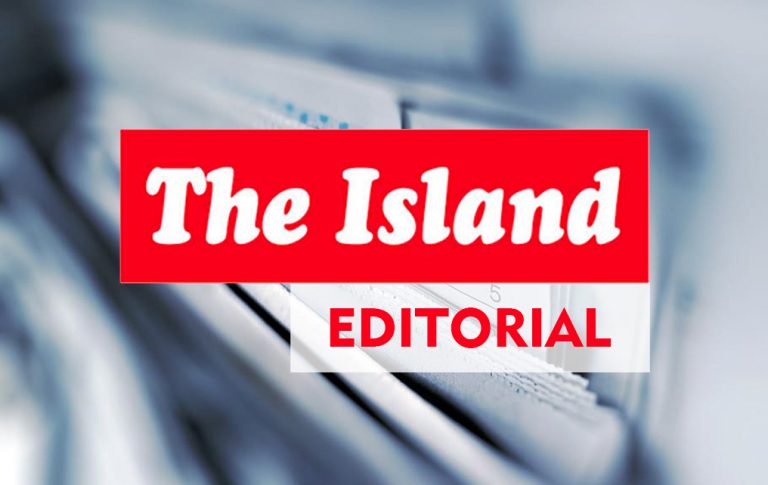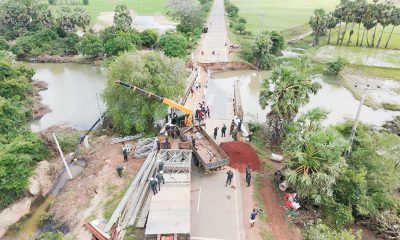Editorial
Properly compensating road accident victims

An English morning newspaper last week editorialized on a very well known fact: that motorists, often under the influence of liquor, driving top end vehicles at breakneck speed causing death and destruction, too often get off very lightly. It urged that the culprits should not be easily let off the hook with a one-off compensation payment but should be required to support the victim’s wife and children as long as needed. We heartily endorse this suggestion but wonder whether it is a practical possibility. The editorial under reference was hung on the peg of a recent accident in Colombo when the driver of a Mercedes Benz luxury car driven at high speed careened into a slow moving three-wheeler going in the same direction killing its 52-year old driver pronounced dead on admission to hospital or shortly thereafter.
A columnist writing to The Island, our stablemate, said in her Friday column that she knew the victim, Tuan, who her friends had teasingly dubbed ‘your white-capped charioteer,’ very well. He plied his own vehicle for hire and was a remarkably fine man whom she had warmly recommended to her friends. He was ever helpful and scrupulously honest, once returning a bag containing some clothes and Rs. 20,000 a passenger had left in his vehicle. Not succeeding in finding the woman owner, he had requested the columnist who he often drove to the Crescat apartments on the Cinnamon Grand grounds to inquire for somebody helping in an apartment there who may have lost the bag. That was because he had picked up the fare outside the hotel. He intended handing the bag over to the police if the owner couldn’t be otherwise found.
As luck would have it, the person who lost the bag was working for our columnist’s friend. The bag was returned with the contents intact and the reward offered declined. It was only accepted on the insistence of the grateful owner. This man who wouldn’t take hires during Muslim prayer time when he went to the mosque, also volunteered now and again to help sink wells in remote Muslim villages. Such a man with teenage daughters was cut down in the prime of life by a reckless driver, possibly under the influence of liquor who has spent the previous night carousing at a nightclub. He vanished from the scene of the crash leaving two female companions accompanying him to face the music from angry onlookers. Hours after the accident he had enplaned for Dubai returning next day to be arrested by the police on arrival at the BIA.
Drivers as well as vehicle owners are well aware that they must cover themselves with at least third party insurance to drive on the pubic road. This is required to ensure that third parties, like pedestrians unfortunately injured in a road accident, are protected. But how adequately are such accident victims compensated by the various insurers? There are numerous instances where compensation has been woefully insufficient. Granted guilty parties do make settlements, generally one-off payments. But families of poor victims, cannot or do not, manage whatever they get to tide over the loss of a breadwinner. Granted also that there’s a not uncommon breed who pretend they have been hit by a vehicle to extort what they can. A common ruse is to strike a vehicle passing close to the con artist with the flat of an open hand and yell happuna. A motorist not savvy enough in the ways of such tricksters, making the mistake of stopping the vehicle is immediately confronted with extortionate demands.
A judgment of long ago held that driving a motor vehicle was somewhat akin to walking a tiger on a leash. The dangers of motor vehicles recklessly driven is similar to the tiger breaking loose. “Hold that tiger” was the implied message in that judgment. Published statistics indicate that some 2,419 people had been killed in over 2,000 fatal accidents last year. Over 13,000 were injured, over 5,000 of them critically. No doubt the figures this year are as bad or worse. The Christmas and New Year holiday period invariable sees and exponential rise in drunken driving. While some people take care not to drink and drive, taking taxis to parties and festivities serving alcohol, many more blithely take the wheel hoping they can avoid an encounter with police on their return home.
There’s a National Council for Road Safety under the Ministry of Transport and Highways with a data base of accidents. This indicates that in 2019 a measly Rs. 4.4 million compensation had been paid over road fatalities and just three million rupees to critically injured persons. Given today’s costs, the inadequacy of such payments is self-evident. Not so long ago a group of so-called car enthusiasts engaged in what was called drag racing in deserted Green Path in the dead of night. Neighbours were privy to engine roars and the noise of screeching tyres. But the police, strangely, took little notice. Even though the road was empty there’s always a chance of somebody venturing out or even a homeless tramp on the road being at risk.
Those who saw the grief written on the faces of Tuan’s wife and children, not knowing what a good and fine man he was, obviously reacted angrily to the tragedy. There feelings were aggravated by the fact that the vehicle involved was a Mercedes driven by a rich young businessman probably after liquor. This country has seen too many political brats and rich kids misbehaving in public spaces, most recently with off-road vehicles in the Yala National Park. There is also suspicion that is not unfounded that fatal accidents are sometimes a money making activity for the police. However that be, we can only hope that the conclusion of the investigation into the recent Kollupitiya accident will end favorably for the victims family.
Editorial
Selective transparency

Saturday 27th December, 2025
The NPP government has released a cordial diplomatic letter from Indian Prime Minister Narendra Modi to President Anura Kumara Dissanayake, and gained a great deal of publicity for it as part of a propaganda campaign to boost Dissanayake’s image. Such moves are not uncommon in politics, especially in the developing world, where the heads of powerful states are deified and their visits, invitations and letters are flaunted as achievements of the leaders of smaller nations. However, the release of PM Modi’s letter to President Dissanayake is counterproductive, for it makes one wonder why the government has not made public the MoUs it has signed with India?
PM Modi’s Sri Lanka visit in April 2025 saw the signing of seven MoUs (or pacts as claimed in some quarters) between New Delhi and Colombo. Prominent among them are the MoUs/pacts on the implementation of HVDC (High-Voltage Direct Current) Interconnection for import/export of power, cooperation among the governments of India, Sri Lanka, and the United Arab Emirates on developing Trincomalee as an energy hub, and defence cooperation between India and Sri Lanka.
The NPP government has violated one of the fundamental tenets of good governance––transparency; there has been no transparency about the aforesaid MoUs or pacts, especially the one on defence cooperation. They cannot be disclosed without India’s consent, the government has said. This is a very lame excuse. The JVP/NPP seems to have a very low opinion of the intelligence of the public, who made its meteoric rise to power.
When the JVP/NPP was in opposition, it would flay the previous governments for signing vital MoUs and pacts without transparency. But it has kept even Parliament in the dark about the MoUs/pacts in question.
Ironically, the JVP, which resorted to mindless violence in a bid to scuttle the signing of the Indo-Lanka Accord in 1987, has sought to justify the inking of an MoU/pact on defence cooperation between Sri Lanka and India and keeping it under wraps, about three and a half decades later. The signing of that particular defence MoU/pact marked the JVP’s biggest-ever Machiavellian U-turn. How would the JVP have reacted if a previous government had entered into MoUs with India and kept them secret? It opposed the proposed Economic and Technology Cooperation Agreement (ETCA) between Sri Lanka and India tooth and nail, didn’t it?
Whenever one sees the aforesaid letter doing the rounds in the digital space, one remembers the MoUs/pacts shrouded in secrecy, which have exposed the pusillanimity of the NPP government, whose leaders cannot so much as disclose their contents without India’s consent.
Editorial
Desperate political sandbagging

Friday 26th December, 2025
There is nothing more predictable than surprise in politics. After securing a two-thirds majority in Parliament last year and emerging victorious in most local councils, this year, the JVP-led NPP may have thought that it was plain sailing. But the government now has many unforeseen, seemingly intractable issues to contend with almost on all fronts. The disaster-stricken economy is expected to slow down, with relief and rebuilding costs escalating, and the deadline for the resumption of debt repayment approaching. Vehicle imports are bound to decrease, causing a sharp drop in the government’s tax revenue. The rupee is depreciating fast. As if these were not enough, the government is experiencing serious problems on the political front.
The defeat of the NPP’s budget in the Colombo Municipal Council (CMC), which the JVP/NPP seized control of through extensive horse trading, could not have come at a worse time for the government. The same fate has befallen many other NPP-controlled local councils. Most of all, the NPP has suffered a string of defeats in the cooperative society elections countrywide during the last several months.
Desperate times are said to call for desperate measures. Cyclone Ditwah and the attendant extreme weather events that badly damaged roads, tank bunds and river banks prompted repair teams to resort to sandbag revetment. But there have been many instances where sandbag facings collapsed, unable to withstand the intensity of floods and slope failures. The government politicians who boasted of having carried out swift restoration work have been left red-faced; they have failed to assess the severity of the problems they are trying to solve.
The NPP government has resorted to a method similar to sandbag revetment in a desperate bid to consolidate its control over some local councils which cannot secure the passage of their budgets for want of majorities. Its members have gone to the extent of setting the clock forward in such institutions, meeting in advance of the regular start time and declaring their budgets passed before the arrival of the Opposition councillors. What the NPP did in the Horana Urban Council the other day is a case in point, the Opposition says.
The NPP is accused of having inflated the number of votes for its Galle MC budget amidst a howl of protests from the Opposition and declared victory. The Opposition councillors prevented the council secretary from leaving the auditorium, put the budget to a fresh vote and defeated it. The Opposition has threatened legal action against the Mayors/Chairpersons and the state officials for violating the law. The government is likely to employ a similar method to have the CMC budget passed when it is put to a vote again next week. The JVP has no sense of shame, just like all other political parties that have been in power.
All self-righteous politicians, given to moral grandstanding, lay bare their true faces when their interests are threatened, and they face the prospect of losing their hold on power. The JVP/NPP is now without any right to be critical of its rivals who did not scruple to undermine democratic principles and traditions to retain power.
Gaining control of hung local councils is one thing, but running them to the satisfaction of their members and the public is quite another. The non-majority councils that the Opposition parties have gained control of could face the same fate as the CMC. This situation has come about because the country is without patriotic leaders. Ideally, the political parties that obtained pluralities in the hung councils should have been allowed to control those institutions, and they should have adopted a conciliatory approach and sought their political rivals’ cooperation to serve the public.
The shameful manner in which the NPP acted during the Galle MC budget vote is not unprecedented. One may recall that in January 2024, the SLPP-UNP government did something similar to secure the passage of its despicable Online Safety Bill. The then Speaker Mahinda Yapa Abeywardena stooped so low as to make use of a brawl in the House and declare the Bill passed. Interestingly, the SLPP and the UNP are among those who are raking the NPP over the coals for undermining democratic principles and traditions. So much for the self-proclaimed messiahs and their critics.
Editorial
Christmas spirit, relief and pledges

Thursday 25th December, 2025
Christmas has dawned while Sri Lanka is reeling from the cumulative impact of multiple disasters which snuffed out hundreds of lives and destroyed many homes and livelihoods. It is a time of hope. Its ethos, which emphasises hope, compassion and giving, could not be more relevant in these difficult times when the task of looking after a large number of disaster victims and helping rebuild their shattered lives has become a top national priority.
Santa came here the other day, as it were. There was no magical flight of a sleigh pulled by reindeer across the night sky. Instead, a jet landed at the BIA, and out stepped Indian External Affairs Minister S. Jaishankar. He unveiled a generous disaster relief and reconstruction package from India and flew back. This noble act of giving exemplifies the spirit of Christmas as much as good neighbourliness.
The best way the Sri Lankan rulers can show appreciation for generous assistance from India and other nations is to uphold accountability, rationalise disaster relief and ensure that it is distributed in a transparent manner. There are disturbing reports about political interference with the disbursement of funds among disaster victims. A high-level probe must be conducted into these allegations.
Christmas is also the season of giving and forgiving. The irony of Minister Jaishankar meeting President Anura Kumara Dissanayake, who is also the leader of the JVP, may not have been lost on keen political observers. If the JVP had acted wisely, heeding religious tenets, and pursued its political goals without resorting to violence, in the late 1980s, tens of thousands of precious lives and state assets worth billions of rupees could have been spared. India has forgiven the JVP, which it even helped gain international legitimacy and shore up its electoral chances in the run-up to last year’s presidential election. India has also helped Sri Lanka manage its worst-ever economic crisis and the impact of natural disasters. The people of Sri Lanka have also forgiven the JVP, despite its past violence, as evident from its impressive electoral victories last year. Sadly, the JVP is not willing to forgive its political enemies. Its General Secretary Tilvin Silva himself has said so. It ought to soften its stand.
All political leaders in this country usually issue well-written Christmas messages, extolling the core Christian virtues, such as giving, forgiving, compassion and peace-making. If only they lived up to the ideals they claim to cherish, at least while the country is struggling to recover from a series of natural disasters. Unfortunately, their post-disaster political battles are intensifying apace, and one wonders whether their focus is actually on helping disaster victims or furthering their political interests. They are not willing to sink their political differences for the sake of the disaster victims crying out for relief.
Meanwhile, the government leaders ought to go beyond issuing Christmas messages if they are to prove that they actually care about the believers in Jesus Christ. They ought to fulfil their pledge to serve justice for the victims of the Easter Sunday terror attacks (2019), which claimed more than 275 lives.
About seven years have elapsed since that tragedy which could have been prevented if the then government had heeded intelligence warnings, and the country has had four Presidents and three governments. But the promises made by the political leaders to bring the masterminds behind the Easter Sunday carnage to justice have gone unfulfilled. Those who are desperately seeking justice pinned their hopes on the current leaders who vowed to trace and prosecute the terror masterminds expeditiously.
The present-day leaders, too, have chosen to remain silent on their promise at issue; they are impervious to calls for justice, just like their predecessors. Let fulfilling their pledge to serve justice for the Easter Sunday terror victims be one of their Christmas resolutions.
-

 News5 days ago
News5 days agoMembers of Lankan Community in Washington D.C. donates to ‘Rebuilding Sri Lanka’ Flood Relief Fund
-

 News3 days ago
News3 days agoBritish MP calls on Foreign Secretary to expand sanction package against ‘Sri Lankan war criminals’
-

 Business7 days ago
Business7 days agoBrowns Investments sells luxury Maldivian resort for USD 57.5 mn.
-

 News6 days ago
News6 days agoAir quality deteriorating in Sri Lanka
-

 News6 days ago
News6 days agoCardinal urges govt. not to weaken key socio-cultural institutions
-

 Features7 days ago
Features7 days agoHatton Plantations and WNPS PLANT Launch 24 km Riparian Forest Corridor
-

 Features7 days ago
Features7 days agoAnother Christmas, Another Disaster, Another Recovery Mountain to Climb
-

 Features5 days ago
Features5 days agoGeneral education reforms: What about language and ethnicity?













